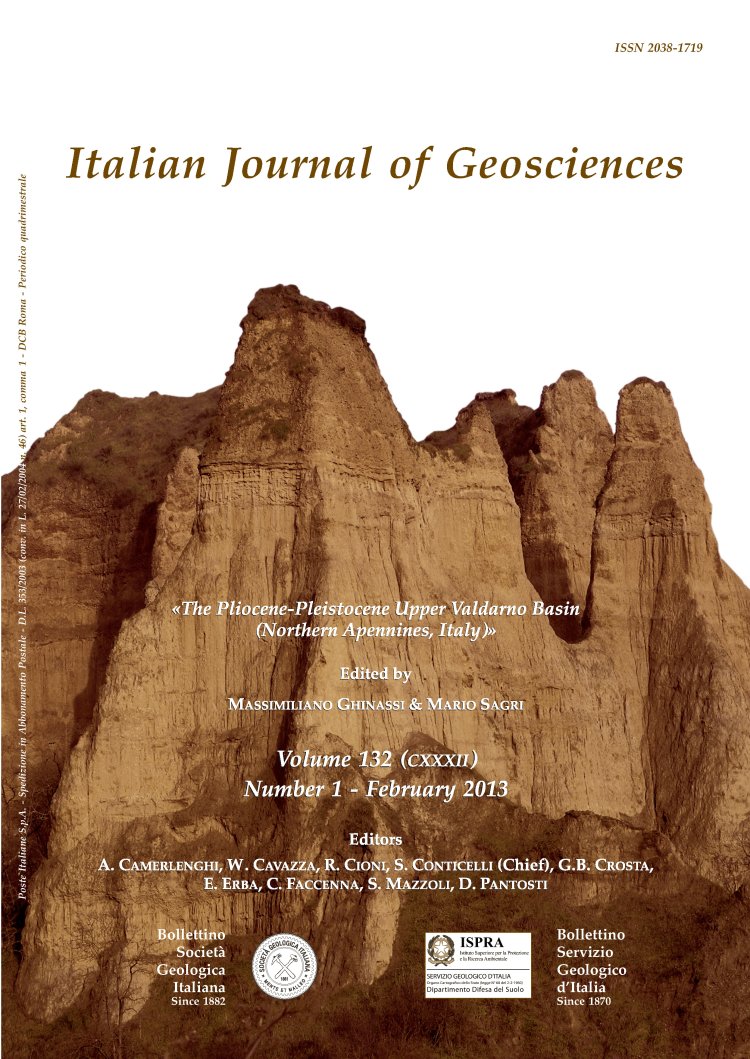
The Plio-Pleistocene fluvio-lacustrine Upper Valdarno Basin (central Italy): stratigraphy and Basin fill evolution
Francesco Fidolini(*), Massimiliano Ghinassi(**), Maurizio Magi(*), Mauro Papini(*) & Mario Sagri(*)
(*) Dipartimento di Scienze della Terra, Università degli Studi di Firenze, Via G. La Pira, 4 - I-50121 Firenze, Italy.
(**) Dipartimento di Geoscienze, Università degli Studi di Padova, Via Gradenigo, 6 - 35131 Padova, Italy. Corresponding author: massimiliano.ghinassi@unipd.it
DOI: https://doi.org/10.3301/IJG.2012.06
Volume: 132 (2013) f.1
Pages: 13-32
Abstract
The Upper Valdarno Basin stands out from the Neogene-Quaternary basins of the Northern Apennines given its outstanding fossil mammal record, good quality of natural and artificial outcrops and remarkable chronological control on the basin-fill succession. The present paper aims to summarize the stratigraphic and sedimentological studies focused on the Upper Valdarno Basin during the past decades, and integrate them with recent investigations. The Upper Valdarno Basin is located about 35 km SE of Florence between the Chianti Mountains and the Pratomagno Ridge. It consists of a main asymmetric tectonic depression filled with 550 m of Plio-Pleistocene fluvio-lacustrine deposits (Upper Valdarno Basin s.s.) and a minor basin known as the Palazzolo sub-basin. The Upper Valdarno Basin
fill is made of three unconformity-bounded units, named Castelnuovo dei Sabbioni (CSB), Montevarchi (VRC), Torrente Ciuffenna (UFF) synthems, whereas the Palazzolo sub-basin fill consists of the Fosso Salceto (OLC) and Torrente Ciuffenna (UFF) synthems. The Upper Valdarno Basin formed during Late Pliocene because of the tectonic damming of a northeastward flowing drainage. The early phase of basin development is recorded by the accumulation of fluvial gravels in vallive settings, whereas the definitive of these streams damming caused the development of lacustrine conditions at about 3.1 Ma. The accumulation of deltaic sand fed from the SW margin caused the lake filling and stopped the deposition of the CSB Synthem.
Before 2.58 Ma, a tectonic phase caused uplift of the basin and partial erosion of the CSB deposits. Deposition of the lower part of the VRC Synthem occurred during a marked basin broadening and accumulation of alluvial fan successions, which were capped by aeolian-reworked alluvial sand deposited at about 2.5 Ma. At about 2.3 Ma, a new deformative phase caused further basin widening, erosion along the SW margin and development of a small lake in
the central areas. Deposition of the upper part of the Montevarchi Synthem started just after this tectonic phase and was characterized by development of axial fluvial drainage and marginal alluvial fans.
During the Early Pleistocene (Olduvai Subchron, 1.95-1.78 Ma) a subsidence pulse promoted development of floodplain lakes and swamps in the axial part of the basin, where thick organic-rich mud were accumulated. During late Early Pleistocene the capture of the paleo-Arno River, which started to flow into the basin, caused the development of a marked unconformity. This unconformity was covered by fluvial and alluvial fan deposit in the axial part and along the margin respectively.
Keywords
Get Full Text Attached